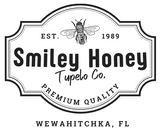
In the summer of 2013, I got a nasty 2nd degree burn on the inside of my forearm while moving a hot pan of melted beeswax. The affected skin area was about 2 inches in diameter. As an experiment, I treated the wound with raw honey, applying small dab of honey each morning when I changed the dressing.The burn healed quickly and completely. Today, it is almost impossible to see where the burn was. While I was grateful for the healing properties of honey, I did not really understand how it worked. Today, while reading the book Honey: The Gourmet Medicine, I learned how honey treats and heals skin wounds.
Raw honey contains small amounts of the enzyme glucose oxidase. Under the right conditions, glucose oxidase breaks down into gluconic acid and hydrogen peroxide. Hydrogen peroxide has long been used as a disinfectant, but it tends to lose its effectiveness fairly quickly when exposed to air and light. Raw honey solves this problem by producing small amounts of hydrogen peroxide directly in the bandaged wound.
Two things are required to convert glucose oxidose into hydrogen peroxide -- a pH of 6.1 and at least 2300 ppm of sodium. Neither of these conditions are present in raw honey, which has a pH level of between 3.2 and 4.5, and traces of sodium in the 20 to 40 ppm range. Human skin and body fluids solve this problem. As explained in Honey: The Gourmet Medicine: [W]hen honey comes into contact with human skin or wounds, the dormant enzyme - glucose oxidase - becomes highly active at the interface of the honey and skin or wound, as bodily fluids raise both the pH and the sodium concentrations to the optimum range of enzyme activity. Thus, minute doses of hydrogen peroxide are continually released from the honey, directly to where they are most needed. Could man devise a more perfect, slow-release antimicrobial product for treating wounds? If a billion dollar, biomedical company gave their research and development scientists unlimited time and resources, it is doubtful they could equal what nature has already provided in honey." Honey: The Gourmet Medicine by Joe Traynor, at pages 11-12,



